“Beurre,” a Short Film about Butter—by Ewan Turner
Some fun from my film-making son Ewan Turner, 2:20 in length, viewable here. Apologies to Edith Piaf.
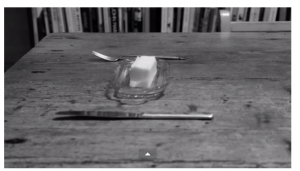
If you are not happy with the results below please do another search
Some fun from my film-making son Ewan Turner, 2:20 in length, viewable here. Apologies to Edith Piaf.

As I’d tweeted earlier tonight and shared here, Ewan Turner was going to be playing at the Bitter End tonight and it turned out to be a terrific night. The venerable music room—which has hosted such legendary performers as Joan Baez, Van Morrison, Bob Dylan, and Miles Davis—was quite full, and attentive to Ewan’s songs. He did six of his own songs, and he had time for one cover, Dylan’s “Abandoned Love,” a song that he told the crowd he’d learned Dylan had performed only once live, at the Bitter End, back in 1975. Here are images from the evening, beginning with a shot of an old poster in the club window, indicating many of the people who have played the venue over the years.

Looking for live music to cap a gorgeous NY day? Ewan Turner’s playing his songs, 7pm @BitterEndNYC Grnwch Village. http://t.co/kdtYIj7H0T
— Philip Turner (@philipsturner) May 25, 2014
Philip Turner Book Productions is an editorial consultancy joined to a literary agency. Our company is comprised of my son Ewan Turner, Executive Editor, who came on-board in 2020, and me, Philip Turner, a publishing veteran with more than four decades of experience in all parts of the book business. Ewan is heading up New […]
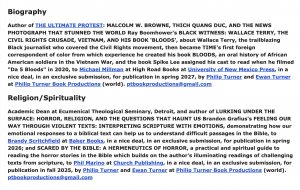 At Philip Turner Book Productions, we’re excited to announce three new deals for two of our authors.
At Philip Turner Book Productions, we’re excited to announce three new deals for two of our authors.
This week with my business partner Ewan Turner we sold Ray E. Boomhower’s latest biography of a journalist, Black Witness: Wallace Terry, The Civil Rights Crusade, Vietnam, and His Book ‘BLOODS‘ to the High Road Books imprint at University of New Mexico Press. This is the third book we’ve sold to UNMP for Ray Boomhower. The earlier books were biographies of Richard Tregaskis, who during WWII wrote the bestselling book of firsthand reportage, Guadalcanal Diary, and Malcolm Browne, AP Bureau Chief in Saigon in the early years of the Vietnam War—he took the shocking photograph of the Buddhist monk who self-immolated in protest against the South Vietnamese government. #CivilRights #VietnamWar #OralHistory #Journalism #biography
We’re also excited with two deals we’ve made for biblical scholar Brandon Grafius, Feeling Our Way Through Violent Texts: Interpreting Scripture With Emotions to Baker Academic Publishing and Scared by the Bible: A Hermeneutics of Horror to the Morehouse imprint at Church Publishing. These are the second and third books we’ve sold for Brandon Grafius. The first book of his we sold was Lurking Under the Surface: Horror, Religion, and the Questions that Haunt Us (Broadleaf Books, 2022). #Horror #Bible #Hermeneutics #Text
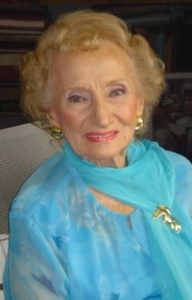 Ruth Gruber April 2007[/caption]
Ruth Gruber April 2007[/caption]
A few months ago, while undergoing an ultrasound for something disconcerting I’d found on my body—which mercifully turned out to be, officially, nothing—I was suddenly hit by a wave of gratitude for an old friend: author and photojournalist Ruth Gruber, who despite our wide age gap was one of my closest confidants, and even at times a surrogate grandmother.
The reason for my gratitude was simple: in 1944, as a newly appointed general by the Roosevelt Administration she personally escorted 972 refugees to America; many, though not all, were Jewish. Among these refugees was a man named Alex Margulis who, as chronicled in Ruth’s 1983 book Haven, would go on to invent the CT Scan, MRI, and other examples of medical imaging technology which have saved an unfathomable and beautifully absurd number of lives. As I was having my procedure I couldn’t help but think of Ruth, and all she meant to me, and to the multitude of people who knew her. After passing away in 2016, at the age of 105—nerd that I am, I admit it’s titillating to use the actual numerals for her age, as in the Chicago Manual of Style only numbers under 100 are spelled out—she left behind a legion of admirers, followers, and yes, even fans. I consider myself as belonging to the latter category, but at the start my connection to her was a personal one. Yet beyond personal and professional appreciation lies my aforementioned feeling, gratitude: especially as the technician utilized that life-saving device and informed me with a wink that, because the doctor did not want to see any more, I was “good.”
***
I don’t recall the first time Ruth and I met, but it had to have been around my seventh or eighth year—as in 2004, when I was still very young I subjected her to an interview, filmed by my mother on a camcorder, one steamy day in August, while I was on summer vacation. I still have the video, rendered into digital form but no less evocative of that early VHS period: amid wavy lines there I am, in almost knee-high white socks, sitting lackadaisically in a stuffed armchair, rattling off a list of question I had memorized, forgotten, then memorized again; while Ruth herself, looking dignified and very well at just ninety-three, listened and nodded and tried with honesty and precision to answer my questions—the questions of an eight year old who was very much wowed by her, and kept repeating after her every statement “That’s a great answer!” in an effort to impress a woman who could not have been kinder-hearted or more willing to engage with a young person.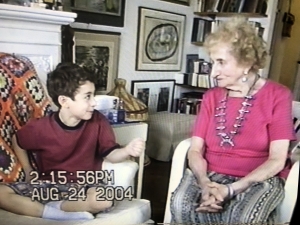
It is important to stress the reason for my early acquaintanceship with her which soon blossomed into a friendship: my father was her editor—and according to a quip she made on more than one occasion at dinner parties and events to the chagrin of some present, he was her favorite editor. This favoritism was likely rooted in her appreciation of his no-nonsense editing style, and his direct, fearless approach to publishing. It matched her own brand of journalism, which was in the words of one of her mentors Edward Steichen to “Take pictures with her heart.” Not only did she take pictures with her heart, she wrote with it too! As any of her readers know there is a declarative majesty to her prose that is only outmatched by her subject matter; she had so much to say and a great deal of life experience to back it up—whether becoming the youngest Ph.D. in the world, doing so in Germany in the mid-thirties and seeing the tail end of the Weimar Republic give way to Nazi Germany; or having tea with Virginia Woolf in London—the very subject of her thesis—and being struck by the author’s corrosive nonchalance, and low-grade anti-semitism, while still managing to hold a nuanced view of her; or when in 1944 she, as mentioned, escorted by ship nearly a thousand refugees who were escaping persecution in Europe, and fighting for them to be accepted by the virulently anti-immigrant State Department, despite President Roosevelt being considered a friend to the Jews.
This is to say, she had something unique—content. Like other, more famous writers and journalists of the time—Hemingway, Dos Passos, and Gellhorn come to mind—after literally living her stories, she put her experiences into words that could be understood by everyone. But her egalitarian style permeated not just her written work but the way she spoke about her career—this held even while speaking about it to me on that sultry day in 2004 when my mom and I stopped by to see her to conduct and impromptu interview. There would be many days and evenings like this, when we would look at each other, and one of us would ask: “Do you want to go see Ruth?” and the answer was always, invariably, the same.
***
Ruth had been living in the Eldorado—a quintessentially regal Central Park West apartment building—for several decades when I first became acquainted with her. Just going over there was a grand experience for me; at the time I had not yet glimpsed New York’s magisterial splendor; the lobby looked like an art deco palace. But visiting Ruth was the start of something more than architectural or stylistic appreciation. I can easily recall these visits as the first time I considered an importance beyond the aesthetic; or rather, that the aesthetic and the moral and meaningful could coalesce into something highly impactful: the notion that one’s life could be an adventure.
[caption id="attachment_17660" align="alignleft" width="202"]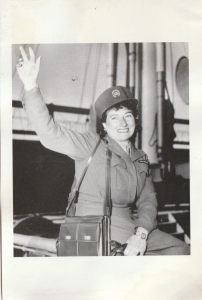 Ruth Gruber embarking on the voyage to bring nearly 1000 refugees to America in 1944. They sailed from Naples, Italy, crossing the Atlantic protected by a convoy of US warships. The story is told in her book, “Haven,'” and the 2000 CBS miniseries of the same name, with Natasha Richardson cast as Ruth.[/caption]
Ruth Gruber embarking on the voyage to bring nearly 1000 refugees to America in 1944. They sailed from Naples, Italy, crossing the Atlantic protected by a convoy of US warships. The story is told in her book, “Haven,'” and the 2000 CBS miniseries of the same name, with Natasha Richardson cast as Ruth.[/caption]
It was this adventurous spirit that Ruth embodied, as well as a presentation of self that prized dignity and demeanor. Whenever we saw her—it didn’t matter if we had come on three consecutive Sundays—she got dressed up; always with her light gold hair perfectly coiffed; her jewelry always tasteful; her greetings broad and demonstrably delighted, as if she wanted us to know, really know, how glad she was that we had stopped by. And we stopped by many times, whether to simply have tea and talk, or to take her out to Central Park, or even have dinner with her.
It was on these nights that my conception of an intellectual community was formed—namely that such a thing could exist, and that I could be a part of it. This feeling carried over into my schooling; in college I had the unique experience of going with my archives class to visit the New York Public Library to see Virginia Woolf’s diaries, which my friend had been mentioned in, however unkindly by the sadly disturbed writer, whom Ruth saw as a woman trapped by her own mind. Though Woolf used an anti-semitic slur in her journal to describe Ruth, she did not hold a grudge beyond feelings of sadness and disappointment.
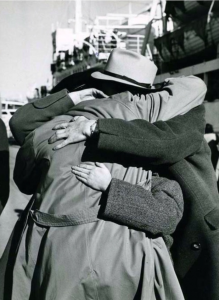 Ruth Gruber photo “The Embrace”[/caption]
Ruth Gruber photo “The Embrace”[/caption]
While I stood with my class looking at Woolf’s pages—most of which were written in a flourishing lavender hand—I knew that among them were those referring to my friend.
Despite Woolf’s callousness, I cherish these kinds of synchronicities. Growing up in New York brings one into the vicinity of great people, particularly if your parents happen to know some of them. These same great people can in their own way sum up entire eras, especially if the person in question is a centenarian. Ruth was born under President Taft and died in November of 2016 while Barack Obama was mercifully still President—though about to leave office to make way for the degraded eventuality that was to come. In one final act of goodness, to add to her litany of mensch-like deeds, the recently turned 105-year-old was taken by her daughter to the polls and cast her last vote for Hillary Clinton. It is unclear whether in the coming hours Ruth was cognizant of the election results, or fully grasped their implication, but it didn’t matter, for she had raised her voice one more time. This was something she’d grown accustomed to, whether from her efforts to counter the anti-semitism and isolationism of the United States government; or in 1944 reporting for the NY Post on the fate of refugees on the ship Exodus; or her early contributions to the newly-named field of Feminism in the 1930s.
***
[caption id="attachment_17662" align="alignleft" width="300"]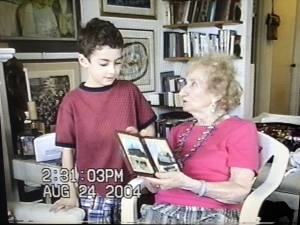 Ruth Gruber is showing me a hinged, painted case my mother, artist Kyle Gallup, made. Inset in the case is a collage Kyle also made comprised of photos Ruth took documenting the refugees on the Exodus ship. It became part of the cover art for Ruth’s book—”Exodus 1947: The Ship that Launched a Nation”—which my father published with Ruth in 1999.[/caption]
Ruth Gruber is showing me a hinged, painted case my mother, artist Kyle Gallup, made. Inset in the case is a collage Kyle also made comprised of photos Ruth took documenting the refugees on the Exodus ship. It became part of the cover art for Ruth’s book—”Exodus 1947: The Ship that Launched a Nation”—which my father published with Ruth in 1999.[/caption]
Despite her far-reaching influence, my dearest recollections of Ruth remain rooted in more personal soil. She was simply an older woman whom I cared for, and who at times felt like a surrogate grandmother to me. Given that my biological grandparents lived far away and I did not see them often, Ruth became a special friend, who was not relation nor teacher, but a figure whose influence was hard to define or put into a single box. It was in fact so unique, that, due to my own immature faculties at the time, I was unable to fully comprehend how lucky we were to know her and be close to her.
Yet where nomenclature fails, one recollection appears to sum up this relationship. And it was that, in my third grade year, she took it upon herself to attend Grandparents Day on my behalf. While most children had their family relations with them, Ruth was at my side, explaining who she was to the awed faces of the class. I remember my mother thanking her, and Ruth saying it was her pleasure—in her parlance everything was almost always “her pleasure”—and walking her back to her Central Park West apartment building where I knew we would soon have another one of our special get-togethers. Sometimes the canvas of memory is confused, disjointed, opaque; but not my memories of Ruth. There is a single beam of clear light which is cast upon all my imagistic renderings of her, and it starkly illuminates the privilege of having sat in her company, of hearing her stories that always seemed to conclude thematically with the victories of dignity over oppression, of passion over indifference—I took these tales to heart without deciding to, for there was something so indelible about her influence. Among her many gifts was the ability to make you feel that life could be made better by the simple act of putting pen to paper, or pressing the camera shutter. Sometimes the simplest actions have the greatest impact; sometimes saving one life can save many others.
Ruth’s influence transcends an easily measurable calculus; many close to her said if she had been a man she would have won the Noble Peace Prize, but Ruth herself did not think in those terms. She simply did the work she was passionate about, and believed to be right, and encouraged others to do the same. For a long life well-lived what more can anyone ask?
October 1, 2022
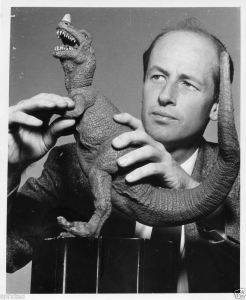 When I was eight years old I had the privilege of meeting one of the greats—in fact the greatest cinema special effects pioneer of the 20th Century. That man’s name was Ray Harryhausen, and to movie fans worldwide he represents the start of a great age in filmmaking, where the previously unthinkable could be projected on screen, using two primary techniques, known as Stop-Motion Animation, and Dynamation, which each pushed the boundaries of what had previously been possible in the fantasy, adventure, and sci-fi realms. But to me, Ray Harryhausen, for all his cinematic splendor and cultural renown, represented something else: magic. For me, this took the form of an idea, that art was not only impressive and important, that it could also be fun.
When I was eight years old I had the privilege of meeting one of the greats—in fact the greatest cinema special effects pioneer of the 20th Century. That man’s name was Ray Harryhausen, and to movie fans worldwide he represents the start of a great age in filmmaking, where the previously unthinkable could be projected on screen, using two primary techniques, known as Stop-Motion Animation, and Dynamation, which each pushed the boundaries of what had previously been possible in the fantasy, adventure, and sci-fi realms. But to me, Ray Harryhausen, for all his cinematic splendor and cultural renown, represented something else: magic. For me, this took the form of an idea, that art was not only impressive and important, that it could also be fun.
I can’t recall which Harryhausen movie I saw first, but it was probably Jason and the Argonauts, which remains my favorite of his films, though Mysterious Island is a close second. In those days—the early 2000s—I used to watch films on our bulbous, analog TV set. This included VHS tapes and eventually DVDs that we rented from our neighborhood video store and some of the first films I watched were Harryhausen’s. Something I used to do, in lieu of being in a real theater, was use chairs, pillows, and then a large bed-sheet to create a kind of makeshift fort, inside of which I could watch films. This had a curious cave-like effect and helped pull my focus to the images on screen, which were dazzling, especially to my young, uncritical mind. This was long before IMAX, and 48 frames per second, and on the fly CGI; this was an only child discovering one of his first artistic heroes, a man I would go on to meet, whom I would initially correspond with over a series of letters, first sent in the fall of 2003.
At that time I was starting second grade, and for my first two years in school had faced a great deal of bullying and harassment from other kids. I was always shy and quiet, preferring to read Harry Potter or The Lord of the Rings instead of running wild with my classmates on the playground. As many people are subjects of bullying and intimidation early in their school years, I don’t suggest I was unique in this, but do think it intensified my wish to escape into other worlds, to lose myself in some grand swashbuckling action. I was looking for something to fill the void, and though the Lord of the Rings trilogy, and the Star Wars space opera did some of the work, it was really Harryhausen who made me feel complete, Harryhausen who opened my mind and showed me that movies could be both entertaining and meaningful. In short, that they could be art.
With my mother herself being a visual artist, I already knew that art was an important element of one’s emotional and intellectual life, but I didn’t know it could also be fun. Seeing Harryhausen’s creatures come to life not only felt like the most special sort of magic trick, but an experience akin to walking through the halls of a wondrous and thought-provoking museum, which in those difficult days of 1st Grade helped me see that there was something outside of the difficult, tedious, and at times Kafkaesque experience of New York public school with its inane standardized tests, its lack of discipline, and myriad bureaucratic cruelties.
Thus I escaped into Harryhausen’s movies, watching them on the weekends, and sometimes on school nights. I even watched all the Sinbad films in succession when recovering from a traumatic ear operation. Because I was so moved by them, and because they meant so much to me, and because they had granted me my first glimpse into seeing film as an art-form, and not just a mode of entertainment, I decided to write him a letter.
I was luckier than most kids in this endeavor, because my father was and still is an influential book editor and was able to obtain Harryhausen’s address through his publishing house. In the letters, which I wrote the summer before first grade began, I told him how much I liked his films, that I wanted to be an animator when I grew up, and even included some drawings depicting his monsters. I simply wanted to connect with the man who’d brought wonder into my life, to convey to him, in no uncertain terms, my appreciation, childlike as it might have been. Of course, in our overly critical culture some might look back and say the Harryhausen icons such as the skeletons in Jason, or his Emir from 20,000,000 Miles to Earth, or any of the other colossal creatures which graced his films, didn’t look real per se, it didn’t matter and still doesn’t. There is a suspension of disbelief necessary for appreciating a Harryhausen film, a suspension that modern audiences have become poorly practiced at, but remains important to one’s overall aesthetic health. For a child it was easy to deploy this ability, and to derive enjoyment from the visions he conjured, and so I felt a letter was the best way to express my, well, gratitude.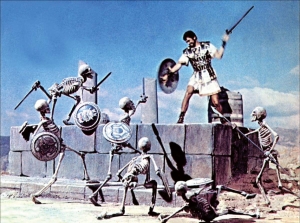
We waited a month or two, and in that time worried that the letter might have gone astray or hadn’t reached him, until finally from England, where the great man lived, a reply came, a photo of which is depicted below. I remember holding the letter in my hands in disbelief, a similar disbelief to the kind I felt when I watched his movies: utter amazement, combined with sheer joy. Reading the letter over and over, I felt I had finally made contact with someone who understood me, and who, in a sense, had freed me from the fear and worry that pervaded so much of my existence. We exchanged another letter or two over the course of the next few months, and after a time our correspondence faltered.
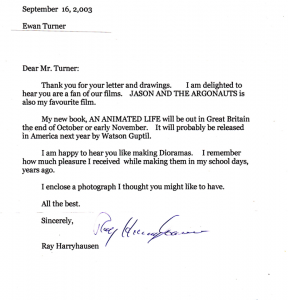 But it did not falter for long, as roughly a year later, my parents received word that a special “Harryhausen Night” was being held at Lincoln Center. Our eventual meeting occurred on a rainy evening in the autumn of 2004, after I had turned eight years old. My mother had discovered that for the release of his heavily illustrated book Ray Harryhausen: An Animated Life (co-authored with Tony Dalton, Watson-Guptill, 2004), the man himself would be speaking and signing copies at Lincoln Center. And like a great New Yorker who knows what she wants and how to get it, she took me to meet him, and managed to get us to the front of the line.
But it did not falter for long, as roughly a year later, my parents received word that a special “Harryhausen Night” was being held at Lincoln Center. Our eventual meeting occurred on a rainy evening in the autumn of 2004, after I had turned eight years old. My mother had discovered that for the release of his heavily illustrated book Ray Harryhausen: An Animated Life (co-authored with Tony Dalton, Watson-Guptill, 2004), the man himself would be speaking and signing copies at Lincoln Center. And like a great New Yorker who knows what she wants and how to get it, she took me to meet him, and managed to get us to the front of the line.
There he was: a handsome, distinguished older gentleman with fraying white hair and a round, inviting face, who in some ways reminded me of my own grandfather, a civil engineer who had his own meticulous pursuits. I remember being nervous but Harryhausen being welcoming in a way that went beyond simple politeness; he seemed genuinely touched that we’d come out to see his classic films, and touched by the nervousness we both showed. And luckily Ray and I were not complete strangers! My mother and I were sure to remind Ray—he was now Ray in my mind—that we’d had a brief correspondence. To this, he said he remembered us and that he was happy to finally meet me in person. It didn’t matter if this was true or not—for all I know he could have received hundreds of fan letters a year from kids like me—but this was all I needed to feel like I had been seen and heard and accepted.
While we stood there, with a legion of people behind us, each waiting anxiously for their own moment with him, I repeated how much I loved Jason and the Argonauts, and The Seventh Voyage of Sinbad, and him smiling and saying how he appreciated my interest. He was also extremely patient as my mother attempted to take a photo of us. After several failed tries—in the picture below you can see in my eyes the fear that this moment would be lost—she managed to snap a few good ones. Ray smiled at us and signed our book and the line continued moving.
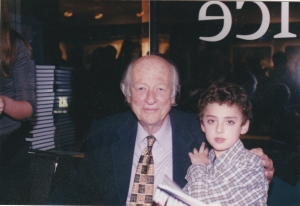 There was a screening happening in tandem with the in-person event, and soon we found our seats in the Walter Reade Cinema at Lincoln Center, settling in for a night of his classic films. Previously I had only been to the theater to see The Lord of the Rings, so this was a special night for me—perhaps one of the most special nights of my young life, and something I consider to be a personal success, though it occurred when age was still in single digits. I was having an experience that most people had not had since the sixties and seventies when his films first hit theaters and later the small screen. In fact, I don’t believe I had had such a unique experience until then, unique because I not only got to see his films in a more enjoyable setting—a great improvement over my unwieldy TV set, over which I had thrown a literal tarp—but meeting my hero in person and being touched by his genuine warmth.
There was a screening happening in tandem with the in-person event, and soon we found our seats in the Walter Reade Cinema at Lincoln Center, settling in for a night of his classic films. Previously I had only been to the theater to see The Lord of the Rings, so this was a special night for me—perhaps one of the most special nights of my young life, and something I consider to be a personal success, though it occurred when age was still in single digits. I was having an experience that most people had not had since the sixties and seventies when his films first hit theaters and later the small screen. In fact, I don’t believe I had had such a unique experience until then, unique because I not only got to see his films in a more enjoyable setting—a great improvement over my unwieldy TV set, over which I had thrown a literal tarp—but meeting my hero in person and being touched by his genuine warmth.
Later, during a break between movies, we met the actress Kathy Crosby (listed in The Seventh Voyage of Sinbad as Kathryn Grant) who starred in that film alongside Kerwin Mathews; she was lovely and down to earth and I think this was the first time I realized that actors and artists and performers were heroes, not only because they achieved the astounding feats of slaying dragons, and fencing with skeletons, and battling evil sorcerers, but because they were, just like Ray, real people. Real people, with the ability to practice a kind of cinematic magic, a shamanistic talent at making the impossible possible. The fact that Harryhausen had not forfeit the interests of his own childhood lent me hope I could participate someday in a great creative enterprise, or even make a career out of it, just as he and his lifelong friend, the renowned sci-fi writer Ray Bradbury had, whose work I was also beginning to discover.
I did not meet Ray Harryhausen again that night; nor did I meet him ever again. He passed away in 2013, long after I had garnered new heroes and new experiences. I changed schools; took up acting; picked up the guitar. My interests waxed and waned. I was drawn more to writing. But even with all the changes I went through, both mental and physical, I never forgot the person who had first made me believe in the unbelievable, who had altered my perception of the movies and made them a place where art happened and not just entertainment. He’d taught me that art, whether it be the manipulation of molded figures, or the manipulation of words on a page, or some other equally valid creative endeavor, is worthwhile and can be meaningful. Sure, you can become discouraged by the elements of creativity; you can be stymied by the logistics of plot and character; you can be interrupted in your painstaking work by a ringing phone or a director calling “Cut!”; you can be disheartened and lose interest altogether in the projects you’d previously been bound to—all that being true, Harryhausen’s lesson is one we can all learn from and take to heart. And it was that magic matters. Stories matter; they make our lives richer. To an only child who had faced some difficulty early in his life, I can honestly say that Harryhausen saved me, not only by his technical prowess, and controlled mayhem, and the delight of sharp teeth and clashing swords, but by the kindness he showed, in replying to a seven-year-old’s hopeful letter. Sometimes the best magic is the kind exchanged from person to person. Or to put it another, clearer, more perfect way: sometimes kindness is the real magic.
M. G. Turner
February 2022
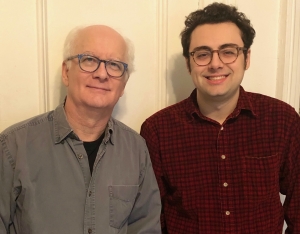 Readers of this blog may recall that last summer I announced here that my adult son Ewan Turner had joined Philip Turner Book Productions as Managing Editor, heading up a new division called New Stories, devoted to cultivating new work, including fiction, narrative nonfiction, and memoir. A BFA graduate of The New School, Ewan is a fiction writer himself, and earlier was the editor of KGB Bar Lit Mag and frequently led readings and open mics at that heralded literary venue. As an editorial assistant, he worked with such writers as playwright Mart Crowley; photojournalist Ruth Gruber; literary scholar Michael Patrick Hearn; and illustrator of the Eloise books, Hilary Knight. He’s also the author of Sotapanna, a poetry chapbook that was featured at KGB Bar and PhotoBookWorks Gallery, Beacon, New York.
Readers of this blog may recall that last summer I announced here that my adult son Ewan Turner had joined Philip Turner Book Productions as Managing Editor, heading up a new division called New Stories, devoted to cultivating new work, including fiction, narrative nonfiction, and memoir. A BFA graduate of The New School, Ewan is a fiction writer himself, and earlier was the editor of KGB Bar Lit Mag and frequently led readings and open mics at that heralded literary venue. As an editorial assistant, he worked with such writers as playwright Mart Crowley; photojournalist Ruth Gruber; literary scholar Michael Patrick Hearn; and illustrator of the Eloise books, Hilary Knight. He’s also the author of Sotapanna, a poetry chapbook that was featured at KGB Bar and PhotoBookWorks Gallery, Beacon, New York.
Looking back on the year that ended last weekend, I see that in 2020 we:
Some of those sales have been noted on this site, such as:
Also in 2020, five books we had earlier sold to publishers were issued. These were:
The Twenty-Ninth Day: Surviving A Grizzly Attack in the Canadian Tundra by Alex Messenger (Blackstone Publishing, trade paperback edition 2020, following 2019 hardcover edition)
The Investigator: Justice and Demons of the Balkan Wars by Vladimir Dzuro (Potomac Books)
The Last Days of Sylvia Plath by Carl Rollyson (University Press of Mississippi, hardcover; Blackstone, audiobook)
Blood Royal: A Sequel to The Three Musketeers by Alexandre Dumas, translated by Lawrence Ellsworth (Pegasus Books)
Bring That Beat Back: How Sampling Built Hip-Hop by Nate Patrin (University of Minnesota Press, also named above)
This month marks my eleventh year as an independent editor and literary agent, and I am more energized than ever by the opportunities to work more closely with authors than I did during my latter years in corporate publishing. Even with the many challenges the book industry is facing, such as bookstores now open for only limited, distanced hours due to the lingering pandemic. I am optimistic about the book business, as readers are eager to have the companionship of books, and writers are driven to tell their singular stories.
We work on a wide range of material, with special affinity for imperative books that really matter in people’s lives. I’m always interested in first-person work from authors who’ve passed through some crucible of experience that leaves them uniquely equipped to write their book. If you have a project you’re developing, or a personal essay, and want to discuss your work, or a project you think may be ready to offer to publishers, please don’t hesitate to contact one or both of us.
Ewan can be reached at ewanmturner [@] gmail [.] com, while my contact info is philipsturner [@] gmail [.] com.
 Tonight, November 18, my son Ewan Munro performed his music live and was interviewed by musician, music teacher, and host Jesse Krakow on his program “Minor Music,” which is devoted entirely to showcasing musicians 18 years of age and younger. It was broadcast on the great indie radio station, WFMU. If you want to listen to the show, which has already been archived on the Internet, please follow this link. If you want to hear Ewan’s recorded songs you will find them at this web page of his on the music-sharing site soundcloud.com.
Tonight, November 18, my son Ewan Munro performed his music live and was interviewed by musician, music teacher, and host Jesse Krakow on his program “Minor Music,” which is devoted entirely to showcasing musicians 18 years of age and younger. It was broadcast on the great indie radio station, WFMU. If you want to listen to the show, which has already been archived on the Internet, please follow this link. If you want to hear Ewan’s recorded songs you will find them at this web page of his on the music-sharing site soundcloud.com.
Krakow has done the program for four years and he will soon learn if he’s going to be renewed by the station for another year. His program is the only outlet of its kind in the New York metropolitan area, and I hope his worthy efforts will be rewarded with an extension. If you agree with me, you can let station manager Ken Freedman know via this contact page on the WFMU site. Here are some pictures from our night at WFMU 91.1/90.1 FM in downtown Jersey City, NJ. Please click here to see all photos.
